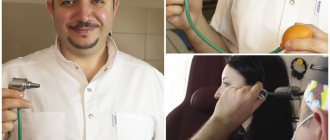Otolaryngologist for adults and children
Manevich
Igor Semenovich
Experience 26 years
Otorhinolaryngologist of the highest category, member of the European Rhinologic Society
Make an appointment
Eustachitis in an adult is an inflammatory process of an acute or chronic nature that occurs in the auditory tube. It is called Eustachian. The disease leads to impaired ventilation in the middle ear, causing severe hearing impairment. This disease is also known as tubo-otitis. It is considered the initial stage of acute catarrhal otitis. Usually the disease appears due to a respiratory infection that has spread so that mucus from the nasopharynx moves to the cavity near the eardrum. Inflammation can be right- or left-sided tubo-otitis, or already develop as bilateral eustachitis.
Symptoms and signs
Symptoms of eustachitis in adults are usually the following:
- increase in body temperature, fever;
- headaches, feeling of heaviness;
- ear congestion;
- tinnitus, ringing;
- temporary hearing loss, but it goes away with yawning or swallowing;
- ear pain that occurs with varying degrees of intensity;
- a feeling that liquid is overflowing (this is especially felt if you change the position of your head).
The symptoms of chronic tubo-otitis are almost no different from acute eustachitis, but they are less pronounced, but the disease is protracted. This situation arises if treatment of tubo-otitis was not carried out in a timely manner or if the patient did not complete treatment, and the inflammatory process remained in an advanced form. Due to the chronic form of the disease, the functionality of the auditory tube may not be restored. Inflammatory processes are less painful.
Do you have symptoms of eustachitis (tubo-otitis)?
Only a doctor can accurately diagnose the disease. Don't delay your consultation - call
How to get rid of noise and ringing in the ears?
Why tinnitus can only be determined by an otolaryngologist, based on the diagnostic results. Anamnesis collection includes systematization of complaints not only about noise effects, but also about other manifestations. Only a thorough diagnosis can help identify one or more causes of auditory discomfort. After treatment of the disease, the symptom will go away on its own.
Only an otolaryngologist should remove wax plugs. Medicines and suppositories lead to perforation of the eardrum, irritation and swelling of the skin in the ear canal, and deposition of wax on the walls. The ENT performs rinsing with saline solution, the jet pressure is selected taking into account the patient’s age. The condition of the hearing aid is taken into account.
If voices are constantly talking, you need to consult a psychiatrist or stop taking medications. This effect can be caused by neuroleptics, barbiturates, narcotic analgesics, strong vasodilators based on periwinkle, heavy industrial chemicals, post-alcoholic state, long-term use of warming ointments based on snake and bee venoms.
Friends! Timely and correct treatment will ensure you a speedy recovery!
In case of vertebral artery syndrome, the symptom is eliminated by non-steroidal anti-inflammatory drugs, and in case of reactive inflammation by glucocorticosteroids. In severe cases, the ringing goes away after 2-3 days.
Make an appointment right now!
Call us by phone or use the feedback form
Sign up
If it rings after a concussion or regular overheating, rest and moderate fluid intake are necessary to avoid swelling of the brain. Take an encephalogram, contact a neurosurgeon, neurologist, and undergo a comprehensive examination. The consequences of these conditions can adversely affect the condition of blood vessels and the central nervous system - a micro-stroke is possible.
Treatment of hypertension consists of normalizing mineral and vitamin balance. Blood pressure medications are used only to relieve symptoms.
For diseases of the brain that provoke swelling, it is not recommended to combine nootropics with aminoglycoside and tetracycline antibiotics - increased side effects such as nausea and headaches.
When using medications to lower blood and intracranial pressure, you must simultaneously take vitamin complexes. The diet should be rich in low-fat fortified foods, a lot of cottage cheese. If you do not follow a diet, refuse vitamin complexes - rupture of capillaries - deterioration of hearing and vision.
For cervical colds, NVP in combination with immunomodulators is recommended. Rubbing with alcohol also has an excellent effect.
Do not use alcohol-based products if you have high blood pressure, blood clots, dry skin, diabetes, or if there are ulcers on the skin.
Swelling of the middle ear can be relieved with vasoconstrictor nasal drops, instilled into the nose.
Osteochondrosis is not the cause of noise effects. To relieve symptoms, you should take antispasmodics to relieve spasms from the muscles that press on the blood vessels.
Causes
Tubootitis is an infectious disease. It can be caused by streptococci, pneumococci, staphylococci, Haemophilus influenzae, as well as mycoplasmas, corynebacteria, etc. Eustachitis can also be caused by viruses. Most often these are adenoviruses, rhinoviruses, influenza virus, respiratory syncytial virus, measles, rubella, mumps virus, coronavirus, etc. The symptoms and causes of tubootitis are interrelated, so before selecting drops for eustachitis, the doctor first identifies the infection that caused this disease.
Also, a separate group consists of the causes of acquired type eustachitis. These include:
- deviated nasal septum;
- blockage of the nasal passage;
- chronic rhinitis and sinusitis;
- excessive blood flow to the nose.
There are also congenital causes. This applies to anomalies associated with the development of the nasal septum, cavity, as well as diverticulum of the Eustachian tube.
Causes of ear congestion
Changes in atmospheric pressure
Congestion in both ears is a typical symptom that most people experience during air travel. Unpleasant sensations are associated with the difference in pressure inside the middle ear and outside. A person feels pressure on the eardrums, which is accompanied by decreased hearing, noise or ringing in the ears. The same symptoms are observed when jumping into water and quickly diving to great depths (swimmer's ear). Usually, the discomfort disappears after the pressure levels are equalized; if congestion persists for a long time, you should visit a doctor.
Otitis
The most common causes of congestion are inflammatory processes of bacterial or viral etiology. Patients experience pressure in the ear, which is combined with unilateral hearing loss and increased perception of their own voice (autophony). The symptom is constantly disturbing, sometimes an unpleasant feeling in the area of the external auditory canal causes intense headaches. With external otitis, there is sharp pain when pressing on the auricle, and purulent or serous discharge from the ear canal is possible.
Severe ear congestion occurs due to inflammation in the tympanic cavity - otitis media. Patients complain of a feeling of fullness and pressure, and hearing on the affected side is sharply reduced. In addition to a stuffy ear, the patient is bothered by sharp pain in the temples. Pathological discharge is uncharacteristic. When the process is started, congestion often turns into temporary hearing loss, which is associated with damage to the eardrum. Self-medication of otitis media is fraught with neurological complications, so you should seek medical help as soon as possible.
Eustachian tube lesion
Normally, the Eustachian (auditory) tube provides communication between the oropharynx and the middle ear cavity, which is necessary to equalize external and internal pressure. Some reasons provoke swelling and closure of the lumen of the organ, while patients feel congestion, bloating and discomfort. In inflammatory processes, the lesion is often bilateral. Depending on the etiological factor, eustachitis is accompanied by a runny nose, sore throat, headache, and fever. Closure of the lumen of the auditory tube is caused by:
- ARVI
: influenza, rhinovirus and adenovirus infection. - Diseases of the nasopharynx
: chronic rhinitis and sinusitis, deviated nasal septum, choanal atresia. - Childhood infections
: measles, scarlet fever, whooping cough. - Allergic pathology, hay fever
. - Complications after nasal tamponade
.
Sulfur plug
When wax accumulates in the outer ear canal, congestion develops gradually. First, there is a feeling of discomfort and a sensation of a foreign body in the ear, then on the affected side the hearing progressively worsens. Patients note constant distension and pressure in the ear canal. Some patients, to eliminate unpleasant sensations, try to rinse the ear themselves, which causes a worsening of the condition, since upon contact with water, the wax plug swells and completely closes the lumen of the external ear canal.
Inner ear diseases
Ear congestion, which is combined with severe dizziness, can be caused by labyrinthitis. Patients associate the onset of discomfort in the ear canal with a viral or bacterial infection or head injury. With moderate severity of the disease, pressure and ringing in the ears occur periodically; as the condition worsens, the symptoms become permanent. Against the background of congestion, hearing loss progresses. Characteristic complaints are imbalance, staggering when walking, nausea and vomiting, which are caused by damage to the vestibular apparatus.
Complications of pharmacotherapy
Most often, pressure and discomfort in the outer ear area appear after taking medications to treat bacterial infections for 2 weeks or more. Along with congestion, patients note progressive unilateral or bilateral hearing loss. After the cause ceases, the unpleasant manifestations may disappear on their own, but if the neurosensory cells responsible for the perception and recognition of sounds are damaged, persistent hearing loss is observed. An unpleasant feeling of pressure and fullness in the ear is provoked by:
- Aminoglycoside antibiotics
: gentamicin, kanamycin, amikacin. - Loop diuretics
: furosemide, ethacrynic acid. - NSAIDs in high doses
: aspirin, indomethacin, diclofenac sodium. - Psychotropic drugs
: amitriptyline, phenazepam, carbmazepine. - Cytostatics
: cisplatin, vincristine, methotrexate. - Anti-tuberculosis drugs
: streptomycin, florimycin, capreomycin.
Rare causes
- Autoimmune diseases
: systemic lupus erythematosus (SLE), scleroderma. - Congenital diseases
: aplasia of the cochlea of the inner ear, cholesteatoma, fetal alcohol syndrome. - Oncological pathology
: tumors of the tympanic cavity, neoplasms of the nasopharynx. - Otosclerosis
. - Occupational hazards
: long-term vibration and noise exposure.
Routes of infection
The infection enters the nasopharynx and disrupts its microflora. It damages the mucous layers, passes into the Eustachian tube, and the tympanic cavity. In response to the reaction, the body produces antibodies that cause allergic reactions (swelling). Infections are transmitted by airborne droplets, that is, when talking with an infected person and staying in the same room. The contact route is also possible, that is, using things (for example, dishes, personal hygiene products) of a previously infected person.
Risk factors
Unilateral or bilateral (bilateral) tubo-otitis may appear due to the following risk factors:
- pathologies of a chronic nature or that have recently arisen and interfere with normal air circulation (for example, a deviated septum, a tumor in the nose, enlarged ears);
- complications after allergic reactions;
- frequent colds, flu and illnesses caused by bacterial or fungal infections;
- chronic sinusitis or rhinitis;
- complications after tonsillitis;
- presence of polyps.
Treatment of tubo-otitis in adults should be based on the causes that caused the disease, since it is necessary to select remedies depending on the infection. Also, symptoms of eustachitis appear in people due to professional activities, this applies to those who, due to their work, are forced to often feel pressure changes, for example, swimmers and divers, pilots. You also need to take into account that the disease can appear due to injury or injury to the ear, as well as as a complication after surgery.
Why does my ears ring for a long time after an allergy to wasps?
The most dangerous allergic reactions to celandine, St. John's wort, Hymenoptera, because:
- the lining of the brain swells;
- the Eustachian tube narrows locally unevenly;
- under the pressure of edematous tissues of the nasopharynx, the cartilages of the nose are slightly deformed, and the cartilages of the auricle are pinched.
In these conditions, you need to drink a moderate amount of fluid. Give preference to fermented milk products. Drink 30-50 ml every 10-15 minutes to prevent nausea and provide access to fresh air. Avoid overheating and hypothermia - the expansion and contraction of blood vessels will increase the noise effects. Avoid physical activity. Walking in a familiar environment, changing the flora can lead to an asthmatic attack.
Diagnostics
How to treat tubootitis? Before choosing a treatment strategy, it is necessary to undergo diagnostics. First, the doctor examines the patient and listens to his complaints, reads the medical record. After this, the following procedures are carried out:
- otoscopy. Such an examination makes it possible to notice inflammation in the Eustachian tube even during the initial examination;
- computer, tone or voice measurement of hearing sensitivity;
- Ultrasound, MRI;
- taking a swab from the ear cavity and nasopharynx.
All of the above procedures can be completed at JSC “Medicine” (clinic of Academician Roitberg) in the central district of Moscow near the Mayakovskaya, Novoslobodskaya, Belorusskaya, Chekhovskaya, Tverskaya metro stations.
Treatment
To treat eustachitis, it is necessary to eliminate the causes of its occurrence. If necessary, the focus of chronic infection should be sanitized: remove the adenoids, perform a tonsillectomy, undergo systemic antibacterial therapy, restore air ventilation in the nasopharynx, correct the nasal septum, remove tumors.
Drug treatment removes swelling and stops inflammatory processes. For this, vasoconstrictor nasal drops and antihistamines are prescribed.
Forecast and prevention of eustachitis
With timely application of appropriate treatment, acute eustachitis resolves within a few days. Concomitant pathologies of the nasal cavity that prevent the normal flow of air into the nasopharynx (tumors of the nasal cavity, deviated nasal septum) can aggravate the situation and provoke the development of chronic eustachitis or adhesive otitis. Chronic eustachitis significantly worsens the patient's quality of life; hearing loss affects the general emotional state of the patient and interferes with normal communication.
The basis for the prevention of this disease is the prevention and treatment of infectious and allergic diseases of the nasopharynx, vitamin therapy during cold periods of the year, avoiding hypothermia, minimizing contact with infectious patients, as well as a healthy lifestyle. If the infection nevertheless penetrates into the nasopharynx and causes swelling of the mucous membrane, it is necessary to use local vasoconstrictor drugs, as well as antihistamines. With rhinitis, it is important to properly blow out mucous discharge; to do this, you need to alternately close each nostril and blow out the contents. Persons with hypersensitivity to various allergens should exclude the possibility of contact with irritating factors. It is worth paying special attention to children's rhinosinusitis, since the anatomy of the children's nasopharynx and ears is predisposed to the rapid spread of infection, as a result of which eustachitis can turn into purulent otitis in a matter of hours. Therefore, in order to prevent such complications, it is worth consulting a doctor in time.
Myths and dangerous misconceptions in the treatment of eustachitis
Myth 1. Treatment is not necessary. Many people prefer to wait out the acute period of inflammation, hoping that the pathology will disappear on its own. In fact, this will cause serious complications.
Myth 2. You definitely need to take antibiotics. If the disease is caused by microbes, then antibacterial therapy will be needed. If eustachitis appears due to a fungal or viral infection, then antibiotics will not be able to cope with them.
Myth 3. Warming up will always help. In fact, warming up is a controversial issue. Because of it, blood flow increases, and the infection spreads faster. This is why you should not warm up the ear during the acute stage of inflammation.
Causes
Clicking in the ears, not associated with swallowing, occurs when the muscles of the hearing aid contract. This occurs with muscle spasm, as well as due to swelling of the auditory tube. Swelling accompanies infectious diseases of the ENT organs (otitis of a bacterial or fungal nature, sinusitis, pharyngitis), Meniere's disease (fluid accumulation in the inner ear), habitual dislocation of the jaw. With arthritis and arthrosis of the jaw joints, patients are bothered by crunching and clicking noises due to damage to the cartilage tissue. Ear plugs lead to pronounced clicking sounds when swallowing, as the patency of the auditory tube is impaired.
Monotonous tinnitus occurs with high blood pressure. The cause may be not only chronic hypertension, but also stress, heat stroke and intoxication. Complex noises that are auditory hallucinations are often a sign of mental illness. In any case, no matter what reason the patient suspects, self-medication is not worth it. A timely visit to an otolaryngologist for diagnosis and treatment is the best solution if noise or clicking occurs.
Prevention
For prevention it is necessary:
- strengthen the immune system (hardening, taking vitamin-mineral complexes, eating garlic or keeping it near you);
- protect yourself from foci of infection (vehicles, public places);
- wear a medical mask (change it every couple of hours during the epidemic);
- Treat colds promptly.
These measures will help avoid the occurrence of inflammatory processes in the Eustachian tube.










